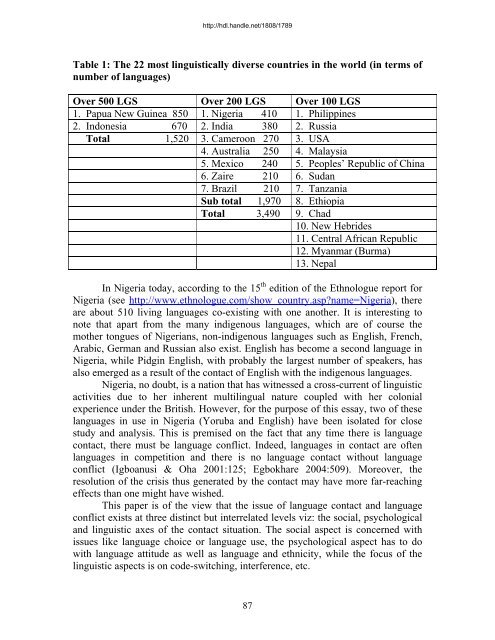LANGUAGE CONTACT AND LANGUAGE ... - KU ScholarWorks
LANGUAGE CONTACT AND LANGUAGE ... - KU ScholarWorks
LANGUAGE CONTACT AND LANGUAGE ... - KU ScholarWorks
You also want an ePaper? Increase the reach of your titles
YUMPU automatically turns print PDFs into web optimized ePapers that Google loves.
http://hdl.handle.net/1808/1789<br />
Table 1: The 22 most linguistically diverse countries in the world (in terms of<br />
number of languages)<br />
Over 500 LGS Over 200 LGS Over 100 LGS<br />
1. Papua New Guinea 850 1. Nigeria 410 1. Philippines<br />
2. Indonesia 670 2. India 380 2. Russia<br />
Total 1,520 3. Cameroon 270 3. USA<br />
4. Australia 250 4. Malaysia<br />
5. Mexico 240 5. Peoples’ Republic of China<br />
6. Zaire 210 6. Sudan<br />
7. Brazil 210 7. Tanzania<br />
Sub total 1,970 8. Ethiopia<br />
Total 3,490 9. Chad<br />
10. New Hebrides<br />
11. Central African Republic<br />
12. Myanmar (Burma)<br />
13. Nepal<br />
In Nigeria today, according to the 15 th edition of the Ethnologue report for<br />
Nigeria (see http://www.ethnologue.com/show_country.asp?name=Nigeria), there<br />
are about 510 living languages co-existing with one another. It is interesting to<br />
note that apart from the many indigenous languages, which are of course the<br />
mother tongues of Nigerians, non-indigenous languages such as English, French,<br />
Arabic, German and Russian also exist. English has become a second language in<br />
Nigeria, while Pidgin English, with probably the largest number of speakers, has<br />
also emerged as a result of the contact of English with the indigenous languages.<br />
Nigeria, no doubt, is a nation that has witnessed a cross-current of linguistic<br />
activities due to her inherent multilingual nature coupled with her colonial<br />
experience under the British. However, for the purpose of this essay, two of these<br />
languages in use in Nigeria (Yoruba and English) have been isolated for close<br />
study and analysis. This is premised on the fact that any time there is language<br />
contact, there must be language conflict. Indeed, languages in contact are often<br />
languages in competition and there is no language contact without language<br />
conflict (Igboanusi & Oha 2001:125; Egbokhare 2004:509). Moreover, the<br />
resolution of the crisis thus generated by the contact may have more far-reaching<br />
effects than one might have wished.<br />
This paper is of the view that the issue of language contact and language<br />
conflict exists at three distinct but interrelated levels viz: the social, psychological<br />
and linguistic axes of the contact situation. The social aspect is concerned with<br />
issues like language choice or language use, the psychological aspect has to do<br />
with language attitude as well as language and ethnicity, while the focus of the<br />
linguistic aspects is on code-switching, interference, etc.<br />
87
















